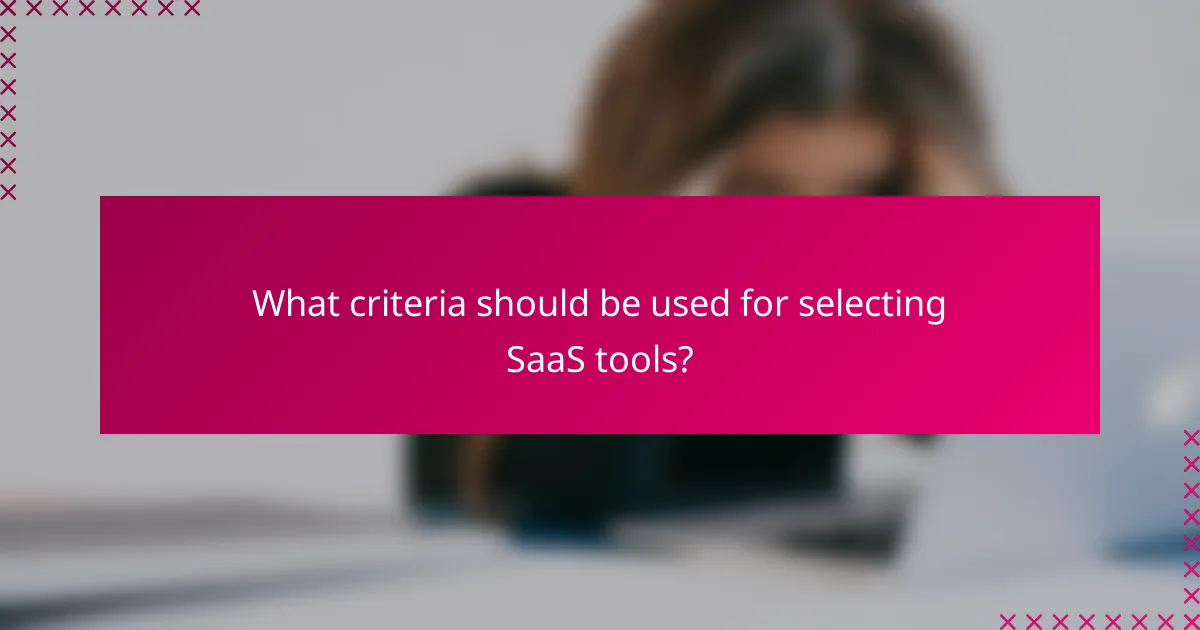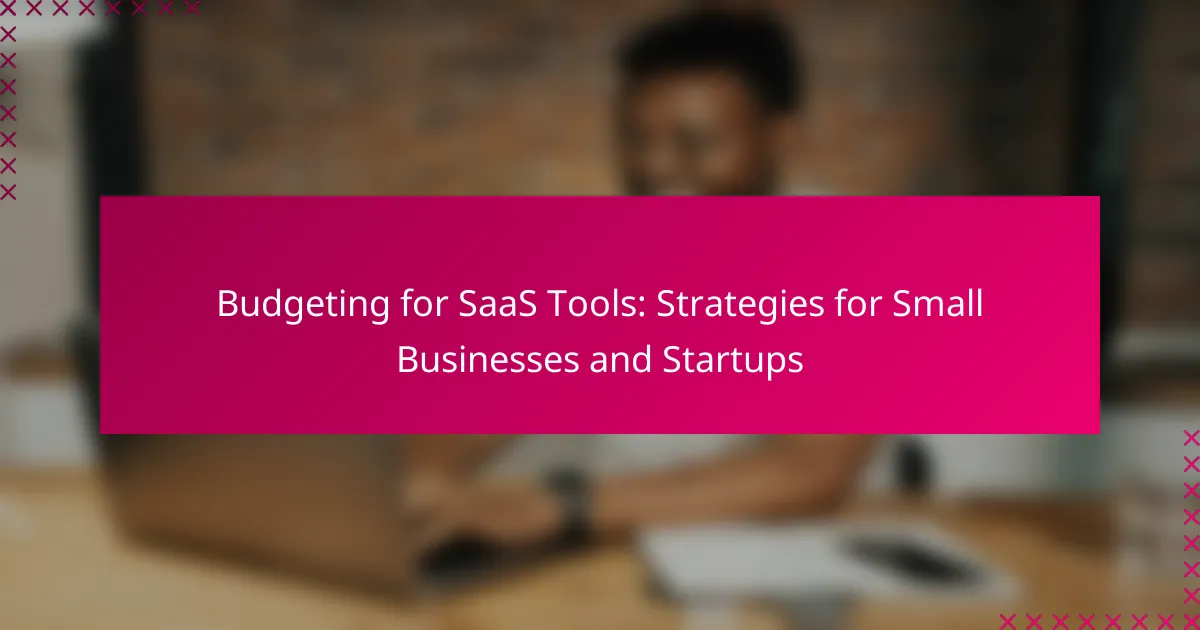Budgeting for SaaS tools is crucial for small businesses and startups looking to optimize their expenses while enhancing productivity. By prioritizing essential software, taking advantage of free trials, and closely monitoring usage, companies can make informed decisions that align with their specific needs and budget constraints. Avoiding common pitfalls, such as hidden costs and underutilization, is key to maintaining financial health in a competitive landscape.

What are effective budgeting strategies for SaaS tools in Canada?
Effective budgeting strategies for SaaS tools in Canada involve prioritizing essential software, utilizing free trials, and monitoring usage to optimize costs. By carefully selecting tools that align with business needs, small businesses and startups can manage their expenses while maximizing productivity.
Prioritize essential tools
Identifying and prioritizing essential SaaS tools is crucial for effective budgeting. Focus on software that directly contributes to your core business functions, such as project management, customer relationship management, or accounting. Avoid unnecessary tools that may complicate workflows or add to costs.
Consider conducting a needs assessment to determine which tools are indispensable. This can involve gathering input from team members to identify pain points and essential functionalities that support your business goals.
Utilize free trials and discounts
Many SaaS providers offer free trials or promotional discounts that can help reduce initial costs. Take advantage of these offers to evaluate whether a tool meets your needs before committing to a subscription. This approach allows you to test features and usability without financial risk.
Additionally, keep an eye out for seasonal discounts or special promotions that can provide significant savings. Subscribing during these periods can lead to lower monthly fees or extended trial periods, enhancing your budgeting flexibility.
Implement usage-based pricing
Usage-based pricing models can be a cost-effective strategy for SaaS budgeting. These models charge based on actual usage rather than a flat fee, which can be beneficial for businesses with fluctuating needs. For example, if you only require a tool during peak seasons, this model can save you money during quieter periods.
Evaluate your usage patterns to determine if this pricing structure aligns with your business operations. This approach can help you avoid paying for unused features or capacity, ensuring that you only spend on what you actively use.
Leverage annual payment options
Opting for annual payment plans instead of monthly subscriptions can lead to substantial savings. Many SaaS providers offer discounts for upfront annual payments, which can range from 10% to 30% off the total cost. This can significantly reduce your overall budget for software tools.
Before committing to an annual plan, ensure that the tool meets your long-term needs. Consider the potential for business growth and whether the software can scale with you, as switching tools mid-year can be costly and disruptive.
Monitor and adjust subscriptions
Regularly monitoring your SaaS subscriptions is essential for effective budgeting. Keep track of usage metrics and assess whether the tools are delivering value. If certain subscriptions are underutilized or no longer meet your needs, consider downgrading or canceling them to free up budget for more critical tools.
Establish a routine for reviewing your subscriptions, perhaps quarterly, to ensure they align with your evolving business needs. This proactive approach can help you avoid unnecessary expenses and maintain a lean budget for SaaS tools.

How can small businesses evaluate SaaS tools?
Small businesses can evaluate SaaS tools by identifying their specific needs, comparing features and pricing, reading user reviews, and assessing integration capabilities. This structured approach helps ensure that the chosen tools align with business goals and budget constraints.
Define specific business needs
Understanding specific business needs is crucial when evaluating SaaS tools. Start by identifying the core functions that the software must support, such as project management, customer relationship management, or accounting. This clarity will guide your search and help filter out unnecessary options.
Consider involving team members who will use the tools to gather insights on their requirements. This collaborative approach ensures that the selected SaaS tools address real challenges faced by the business.
Compare features and pricing
Once you have defined your needs, compare the features and pricing of different SaaS tools. Look for tools that offer essential functionalities without unnecessary extras that could inflate costs. Many SaaS providers offer tiered pricing models, so evaluate which tier aligns best with your budget.
Utilize comparison websites or create a simple spreadsheet to list features side by side. This visual representation can help clarify which tools provide the best value for your specific needs.
Read user reviews and case studies
User reviews and case studies provide valuable insights into how SaaS tools perform in real-world scenarios. Look for reviews on reputable sites and pay attention to comments regarding customer support, ease of use, and overall satisfaction. This feedback can highlight potential issues or advantages that may not be apparent from marketing materials.
Case studies can illustrate how similar businesses have successfully implemented the tools, offering practical examples of benefits and challenges. This information can help you gauge whether a tool is likely to meet your expectations.
Assess integration capabilities
Integration capabilities are essential for ensuring that new SaaS tools work seamlessly with existing systems. Check if the tools can integrate with your current software, such as accounting platforms or CRM systems, to streamline workflows and data sharing.
Consider the ease of integration and any potential costs associated with it. Some tools offer native integrations, while others may require third-party solutions, which could add to your overall expenses. Prioritize tools that minimize disruption and enhance operational efficiency.

What are the common pitfalls in SaaS budgeting?
Common pitfalls in SaaS budgeting include overlooking hidden costs, failing to track usage, and ignoring scalability options. These mistakes can lead to overspending and underutilization of resources, ultimately affecting a business’s financial health.
Overlooking hidden costs
Many small businesses underestimate the total cost of SaaS tools by overlooking hidden expenses. These can include setup fees, training costs, and ongoing support charges that may not be immediately apparent. It’s essential to account for these additional costs when budgeting.
To avoid this pitfall, create a comprehensive list of all potential expenses associated with each SaaS tool. Consider factors such as user limits, data storage fees, and integration costs with existing systems. This approach can help you get a clearer picture of the total financial commitment.
Failing to track usage
Failing to monitor how often and effectively your team uses SaaS tools can lead to unnecessary expenses. If a tool is underutilized, it may not justify the cost, and businesses may end up paying for licenses that are not being used. Regularly reviewing usage metrics can help identify these inefficiencies.
Implement a system for tracking usage data, such as monthly reports or dashboards that highlight active users and feature engagement. This information can inform decisions about renewing subscriptions or switching to more cost-effective solutions.
Ignoring scalability options
Ignoring scalability options can hinder a business’s growth and lead to increased costs in the long run. As your company expands, the SaaS tools you choose should be able to accommodate more users and increased data needs without significant price hikes. Failing to consider this can result in needing to switch providers later, which can be costly and disruptive.
When selecting SaaS tools, evaluate their scalability features, such as tiered pricing models or the ability to add users easily. Look for solutions that offer flexibility to grow with your business, ensuring that you won’t face sudden spikes in costs as your needs evolve.

What criteria should be used for selecting SaaS tools?
When selecting SaaS tools, focus on vendor reputation, customer support quality, and data security measures. These criteria ensure that the tools you choose are reliable, well-supported, and secure for your business operations.
Evaluate vendor reputation
Assessing vendor reputation involves researching their history, customer reviews, and industry standing. Look for established companies with positive feedback from users, as this often indicates reliability and quality service.
Check platforms like G2, Capterra, or Trustpilot for user ratings and testimonials. A vendor with a strong reputation typically has a proven track record of delivering on promises and maintaining customer satisfaction.
Consider customer support quality
Customer support quality is crucial for resolving issues quickly and efficiently. Evaluate the support options available, such as live chat, phone support, and email assistance, and consider the hours of availability.
Look for vendors that offer comprehensive support resources, including documentation, tutorials, and community forums. A responsive support team can significantly reduce downtime and enhance your overall experience with the tool.
Analyze data security measures
Data security measures are vital for protecting sensitive information. Ensure that the SaaS provider complies with industry standards, such as GDPR or HIPAA, depending on your business needs.
Inquire about encryption methods, data backup protocols, and incident response plans. A vendor that prioritizes security will offer transparency regarding their practices and provide regular updates on security enhancements.

How can startups maximize their SaaS budget?
Startups can maximize their SaaS budget by carefully selecting tools that align with their core needs and negotiating favorable terms with vendors. By focusing on essential functionalities and leveraging vendor relationships, businesses can ensure they get the most value from their subscriptions.
Focus on core functionalities
Identifying and prioritizing core functionalities is crucial for startups to avoid overspending on unnecessary features. Start by listing the specific problems your business needs to solve and select SaaS tools that directly address those needs. This targeted approach helps in minimizing costs and maximizing efficiency.
For example, if your startup requires project management, choose a tool that excels in task tracking and collaboration rather than one with a wide range of features that may not be relevant. This can save you hundreds of dollars each month while ensuring your team remains productive.
Negotiate pricing with vendors
Negotiating pricing with SaaS vendors can lead to significant savings for startups. Many vendors are open to discussions, especially if you express interest in long-term commitments or bulk subscriptions. Don’t hesitate to ask for discounts, especially if you can demonstrate potential for growth or a competitive offer from another provider.
Consider proposing a trial period or a pilot program to test the software before fully committing. This not only allows you to assess the tool’s effectiveness but also gives you leverage in negotiations. Always be prepared to walk away if the terms do not meet your budgetary constraints.
